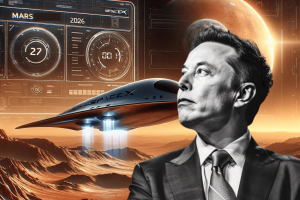Elon Musk plans self-sustaining city on Mars in “about 20 years”

Elon Musk has revealed that SpaceX will launch its first uncrewed Starships to Mars in 2026. The CEO wrote on social media platform X that the launch will be when the next Earth-Mars transfer window opens.
Musk said that the missions will be uncrewed to “test the reliability of landing intact on Mars,” adding that if those landings go well, then the first crewed flights to Mars will be in four years.
“Flight rate will grow exponentially from there, with the goal of building a self-sustaining city in about 20 years,” the billionaire added in the same post. “Being multiplanetary will vastly increase the probable lifespan of consciousness, as we will no longer have all our eggs, literally and metabolically, on one planet.”
SpaceX created the first fully reusable rocket stage and, much more importantly, made the reuse economically viable.
Making life multiplanetary is fundamentally a cost per ton to Mars problem.
It currently costs about a billion dollars per ton of useful payload to the surface… https://t.co/bVQJL8JeV5
— Elon Musk (@elonmusk) September 7, 2024
What is SpaceX’s mission to Mars?In April, Musk who founded SpaceX in 2002, stated that the first uncrewed Starship could land on Mars within five years, and the first human landing on Mars could follow within seven years.
The Starship comprises a Super Heavy first-stage booster and a 165-foot upper-stage spacecraft, which is a stainless-steel construction. The combination forms the tallest and most powerful rocket ever, towering around 400 feet and producing 16.7 million pounds of thrust at liftoff, nearly doubling that of NASA’s Space Launch System (SLS) used in the Artemis moon missions.
Unlike the expendable SLS, Starship is designed for full and rapid reusability. SpaceX’s approach allows the Super Heavy to land directly back on the launch mount, making it easier for quick inspections and relaunches.
In June, a Starship rocket already withstood a fiery, hypersonic re-entry from space and achieved a landmark landing in the Indian Ocean, completing its first full global test mission on its fourth attempt. The Tesla CEO has previously stated that he hopes to make life “multi-planetary,” carrying 100 passengers at a time to Mars.
However, earlier this month, China also announced an ambitious plan to launch its Tianwen-3 mission to Mars in 2028, two years ahead of its previous schedule, aiming to bring back around 600 grams of Martian soil. ReadWrite previously reported on NASA’s call for volunteers to take part in year-long simulation on Mars.
Featured image: DALL-E / Midjourney
The post Elon Musk plans self-sustaining city on Mars in “about 20 years” appeared first on ReadWrite.
